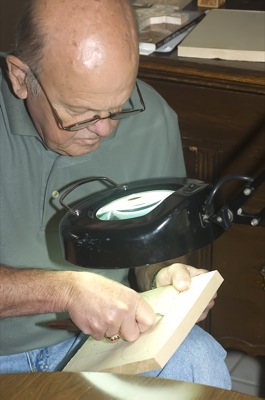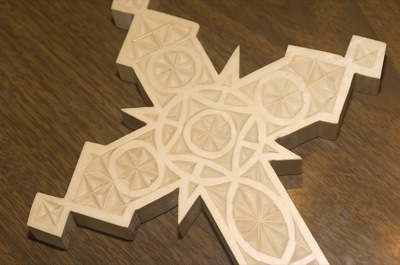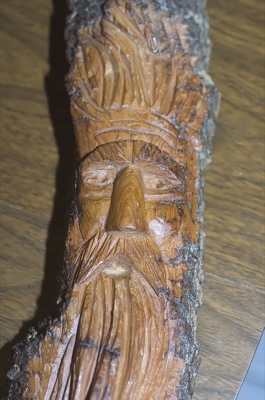Saturday, July 7th, 2007
Carving out the beauty
St. Marys senior citizen discovers new interest to chip away at retirement time
By Margie Wuebker

Photo by Mark Pummell/The Daily Standard
Gene Knox, a resident of the Otterbein Retirement Community in St. Marys, peers through a lighted magnifying glass as he begins chip carving an intricate spiral design. The process involves removing tiny chips of wood with the aid of a curved blade.
ST. MARYS - Gene Knox holds a piece of basswood and sees all the things it could become with deft strokes of his chip carving knife.
At 71, he enjoys the satisfaction that comes from creating crosses by the dozens or freeform designs like snowflakes or green man -a hewn face in the midst of leafy vines.
"Carving has always been a special interest of mine," he says. "I once made a black powder rifle out of a kit and then carved the stock. I also taught myself how to carve love spoons by studying a book from the St. Marys Library."
Knox, who retired as a computer programmer/operator from Textron in Lima, discovered chip carving at a wood carving show about 10 years ago. The process of creating designs by skillfully removing three-sided chips to create intricate patterns dates back to the 8th and 9th centuries when artisans used sea shells, bones and even shark teeth to make repetitive cuts in ceremonial tool handles and boat paddles.
He and his wife, Debbie, initially took a two-day beginner's class offered by Bruce Nicholas in St. Paris. The desire to learn also led to the purchase of books and finally to workshops presented by Wayne Barton. The Chicago artist is considered by many as the world's premiere chip carver, according to Knox.
"I had planned to spend retirement playing golf," he says with a smile. "Then I discovered this and realized there is more than golf to occupy my time. Debbie moved on to watercolor and photography."
Crosses take eight to 10 hours to complete; the green man design even longer. The process begins by sketching the desired pattern on a piece of sanded basswood or butternut, likening the task to a kid working with an Etch-A-Sketch.
Reaching for a unique and oh-so sharp knife, he sends the blade into the wood at a 65-degree angle. Achieving the proper depth and angle comes from years of practice even though he admits there are times when a faux pas leads to an impromptu deviation.
The starting point depends on the design. He typically focuses on the center of a cross before moving to the four outer points. Work on the green man initiates in the right corner and moves toward the left in millimeters instead of less precise inches. Both methods lessen the likelihood of dislodging a chip.
"I always carve with little variations," Knox says. "You'll never find two crosses exactly the same no matter how many I make."
The dining room serves as his studio complete with extra illumination as well as a large magnifying glass out of deference to a cornea transplant he underwent some years ago. A sturdy piece of leather covers his right leg as a shield of sorts.
"These knives are very sharp," he says. "I know from experience ...one slipped as I was working and cut a fourth inch into my leg. That's the reason for the leather."
Every carver has a favorite way to restore the cutting edge after prolonged use. Knox prefers running the curved blade across a sturdy piece of leather every 30 to 40 minutes instead of using polishing compounds.
"You push the tip of the blade at an angle and then pull it through the wood," he says demonstrating the technique on a series of spirals. "With a couple years of experience, you can feel whether the angle and depth are right."
He enjoys working with soft woods like basswood and butternut available at craft shows and selected sawmills. Working with basswood from Wisconsin and Minnesota equates to pulling a hot knife through butter. It also has a whiter appearance than harder Ohio varieties.
"Butternut is beautiful but there are fewer trees around nowadays and therefore the price is higher," he adds. "I've also tried cedar which proved to be fragrant. Each cut unleashed another whiff."
Knox, the father of two, grandfather of six and great-grandfather of four, also practices traditional woodcarving which he refers to as a "far greater challenge."
He brings out a cypress knee bearing a good start on a chisel-nosed spirit face that will one day sport long tresses.
"I like chip carving because it is so much quicker and all the tools fit into a briefcase," he says. "Woodcarving requires more tools and a lot more patience."
Knox, who has survived cancer, an aortic aneurysm and brain surgery, displays his handiwork at craft shows as well as the weekly farmer's market in St. Marys. Although he logs some sales, far more of his creations wind up as gifts to relatives, friends and neighbors.
"I tried teaching fellow members of the Shelby County Woodcarvers how to do chip carving but none of them switched," he says. "You have to be a little bit dingy to do this. I speak from experience."

Photo by Mark Pummell/The Daily Standard
The sharp blade of a chip cutting knife meets a piece of silky smooth basswood as a geometric spiral takes shape. Gene Knox learned the art 10 years ago and has studied with premiere carvers known throughout the world.

Photo by Mark Pummell/The Daily Standard
Intricate crosses have become a specialty of the 71-year-old St. Marys man. There are no carbon copies just variations that keep the work interesting.

Photo by Mark Pummell/The Daily Standard
A spirit face emerges from a cypress knee - one of the examples of traditional woodcarving Gene Knox pursues from time to time.

